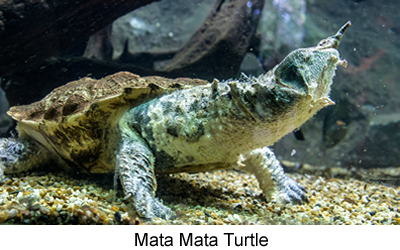 |
|
Name:
Mata Mata Turtle  Classification:
Class: Reptilia
Order: Testuines
Suborder: Pleurodira
Family: Chelidae
Subfamily: Chelinae
Genus: Chelus
Species: C. fimbriata
Size: 16-20 inches,
two feet tops. Characteristics:
Small round shell, four small legs with webbed feet, small tail, long
thick neck with triangular-shaped head. Status:Least
Concern.
There's an oddball in every family. For turtles, that oddball is the mata mata turtle! With a neck almost as long as it's body and its triangular-shaped head, it looks like a cross between a turtle and a snake! Popular as exotic pets, mata matas are freshwater turtles that hail from rivers, ponds and swamps across South America, including Brazil, Ecuador, and Colombia. Mata mata turtles really are the only members of the genus Chelus. They are cousins of other long-necked turtles found in South America, Australia and New Guinea. These critters can get around eighteen inches long and weigh up to 33 pounds. Mata matas spend 99% of their time underwater. They prefer shallow water where they can stick their snouts through the surface like a snorkel. While they are turtles, they are poor swimmers and usually walk along the muddy bottoms of freshwater areas. Mata matas depend on their brown-colored shells and bizarre head flaps to camouflage in the water while they wait for small fish or frogs to eat. Unlike most turtles, mata matas do not bite their prey. Instead they suck them out of the water and swallow them whole! They are active mostly during the day, but also hunt at night. Mating season occurs from October through December. To attract mates, males will jolt their heads forward with their mouths open while moving the flaps on their heads. Females will lay 12-15 eggs, and upon hatching the babies strike out on their own. Mata mata turtles are in strong numbers and are not in immediate danger of becoming extinct. However, they do still face threats. Habitat destruction is a major concern; deforestation affects all animals that live within a rainforest, including many aquatic animals. The illegal wildlife trade is also a threat. Not only does it hurt the numbers of wild turtles, it's also incredibly stressful for the turtles to be taken out of the wild. It is legal to own a mata mata turtle for a pet, but be sure that you buy one from a licensed breeder. NEVER buy an animal that came from the wild! To learn more about these turtles and the rivers they call home, check out these awesome links! Everywhere Wild, "39
Mata Mata Turtle Facts: South America's Fish Vacu-um"-A whole
list of awesome facts! Sciencing, "The Ecosystem
of the Amazon Rainforest"-An overview of the Amazon and the
threats it faces. Amazon Conservation Team-Dedicated
to working with indigenous peoples to protect and live harmoniously
with the Amazon! |
|
|
|
|
||
|
Contact
Us
|
||||
|
Taproot
Guru © ALL RIGHTS RESERVED
|
||||